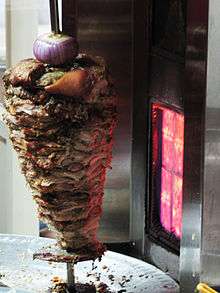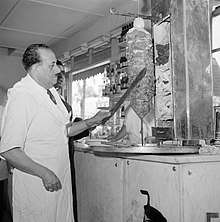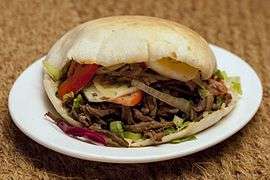Shawarma
Shawarma (/ʃəˈwɑːrmə/; Arabic: شاورما) is a dish in Middle Eastern cuisine consisting of meat cut into thin slices, stacked in a cone-like shape, and roasted on a slowly-turning vertical rotisserie or spit. Originally made of lamb or mutton, today's shawarma may also be chicken, turkey, beef, or veal.[4][5][1] Thin slices are shaved off the cooked surface as it continuously rotates.[6][7] Shawarma is one of the world's most popular street foods, especially in Egypt and the countries of the Levant, the Arabian Peninsula, and beyond.[8]
 | |
| Alternative names | chawarma, shaurma, showarma,[1] other variations |
|---|---|
| Type | Meat |
| Place of origin | Ottoman Empire[2] |
| Region or state | Anatolia, Levant, Middle East[1][3] |
| Serving temperature | Hot |
| Main ingredients | Meat: lamb, chicken, turkey, beef Sandwich: Shawarma meat, pita or wrap bread, chopped or shredded vegetables, pickles and assorted condiments |
| Similar dishes | Doner kebab, al pastor, gyros |
Etymology
Shawarma is an Arabic rendering of Turkish çevirme [tʃeviɾˈme] 'turning', referring to the turning rotisserie.[9]
History

Although the roasting of meat on horizontal spits has an ancient history, the technique of grilling a vertical stack of meat slices and cutting it off as it cooks first appeared in the 19th-century Ottoman Empire, in what is now Turkey, in the form of doner kebab.[1][10][11] Both the Greek gyros and shawarma are derived from this.[1][2][12] Shawarma, in turn, led to the development during the early 20th century of the contemporary Mexican dish tacos al pastor when it was brought there by Lebanese immigrants.[2][13]
Preparations

Shawarma is prepared from thin cuts of seasoned marinated lamb, mutton, veal, beef, chicken, or turkey. The slices are stacked on a skewer about 60 cm (20 in) high. Lamb fat may be added to provide extra fat for juiciness and flavor. A motorized spit slowly turns the stack of meat in front of a heating element, continuously roasting the outer layer. Shavings are cut off the rotating stack for serving, customarily with a long, sharp knife.[1]
Spices may include cumin, cardamom, cinnamon, turmeric and paprika, and in some areas baharat.[13][3] Shawarma is commonly served as a sandwich or wrap, in a flatbread such as pita or laffa.[1][14] In the Middle East, chicken shawarma is typically served with garlic sauce, fries, and pickles.
In Israel, most shawarma is made with dark meat turkey and is commonly served with tahini sauce because serving yogurt sauce with meat would violate the Jewish dietary restriction of not eating milk and meat together.[13] It is often garnished with diced tomatoes, cucumbers, and onions, pickled vegetables, hummus, tahini sauce or amba mango sauce.[1] Some restaurants may offer additional toppings like grilled peppers, eggplant or french fries.[15]
See also
- Arab cuisine
- Israeli cuisine
- Kati roll - meat or other ingredients wrapped in paratha bread
- Lebanese cuisine
- Levantine cuisine
- List of sandwiches
- List of spit-roasted foods
- Middle Eastern cuisine
- Palestinian cuisine
- Shish taouk - small cubes of chicken shish kebab
References
- Marks, Gil (2010). Encyclopedia of Jewish Food. Hoboken, N.J.: Wiley. ISBN 9780544186316. OCLC 849738985 – via Google Books.
- Prichep, Deena; Estrin, Daniel (2015-05-07). "Thank the Ottoman Empire for the taco al pastor". PRI. Retrieved 19 March 2017.
- Salloum, Habeeb; Lim, Suan L. (2010). The Arabian Nights Cookbook: From Lamb Kebabs to Baba Ghanouj, Delicious Homestyle Arabian Cooking. Tokyo: Tuttle Pub. p. 66. ISBN 9781462905249. OCLC 782879761.
- Albala, Ken, ed. (2011). Food Cultures of the World Encyclopedia. ABC-CLIO. pp. 197, 225, 250, 260–261, 269. ISBN 9780313376269 – via Google Books.
- Davidson, Alan (2014). Jaine, Tom (ed.). The Oxford Companion to Food. Oxford Companions. Oxford: Oxford University Press. p. 259. ISBN 9780191040726. OCLC 1119636257 – via Google Books.
- Mattar, Philip (2004). Encyclopedia of the Modern Middle East & North Africa: D-K. Encyclopedia of the Modern Middle East & North Africa. 2 (Hardcover ed.). Macmillan Library Reference. p. 840. ISBN 9780028657714. OCLC 469317304.
Shawarma is a popular Levantine Arab specialty.
- La Boone, III, John A. (2006). Around the World of Food: Adventures in Culinary History (Paperback ed.). iUniverse, Inc. p. 115. ISBN 0595389686. OCLC 70144831.
Shawarma - An Arab sandwich similar to the gyro.
- Kraig, Bruce; Sen, Colleen Taylor (2013). Street Food Around the World: An Encyclopedia of Food and Culture. Santa Barbara, California: ABC-CLIO. pp. 18, 339. ISBN 978-1598849554. OCLC 864676073.
- Al Khan, Mohammed N. (31 July 2009). "Shawarma: the Arabic fast food". Gulf News.
- Eberhard Seidel-Pielen (May 10, 1996). "Döner-Fieber sogar in Hoyerswerda" [Doner fever even in Hoyerswerda]. ZEIT ONLINE (in German). Retrieved May 6, 2016.
Neither in the written recipes of the medieval Arab cuisine nor in the Turkish cookbooks from the first half of the 19th century are there any indications. According to research carried out by the Turkish master chef Rennan Yaman, who lives in Berlin, the doner kebab is an amazingly young creation of Ottoman cuisine. (Quote translated from the German)
- Kiple, Kenneth F.; Ornelas, Kriemhild Coneè, eds. (2000). The Cambridge World History of Food, Volume 2. Cambridge University Press. p. 1147. ISBN 9780521402156 – via Google Books.
Bursa is the town that gave birth to the world-famous doner kebab, meat roasted on a vertical revolving spit.
- Kremezi, Aglaia (2010). "What's in the Name of a Dish?". In Hosking, Richard (ed.). Food and Language: Proceedings of the Oxford Symposium on Food and Cooking 2009. 28. Totnes: Prospect Books. pp. 203–204. ISBN 9781903018798. OCLC 624419365.
- Guttman, Vered (2017-05-01). "How to Make Shawarma Like an Israeli". Haaretz.
- Al-Masri, Mohammad. Colloquial Arabic (Levantine): The Complete Course for Beginners. Routledge.
- Laor, Eran (2019-01-10). "Shawarma, the Iconic Israeli Street Food, Is Slowly Making a Comeback in Tel Aviv". Haaretz.
External links



